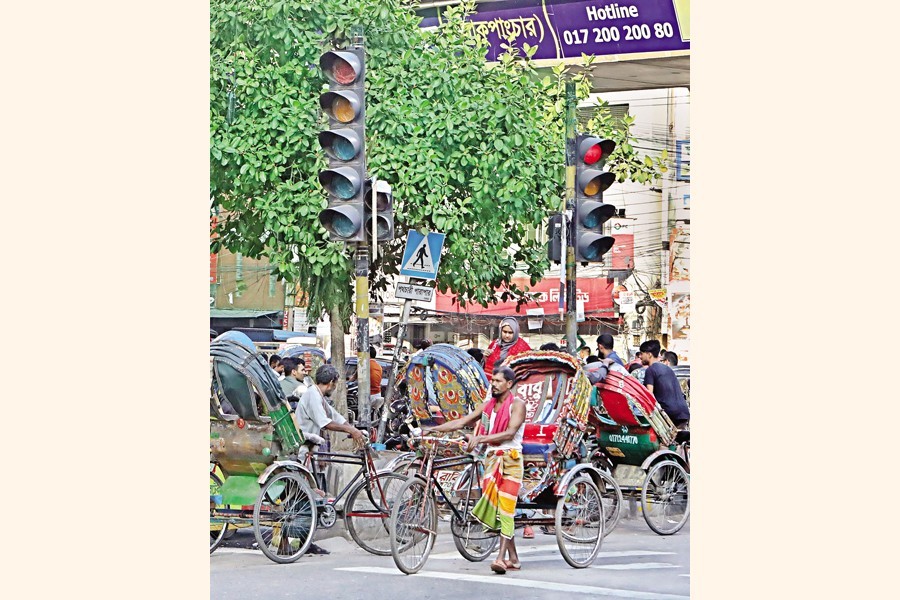Over Tk 1.5 billion has been splurged on projects in 20 years for installing an automated traffic-control system in Dhaka, but to no avail, as vehicle movement is still controlled by outmoded hand signals in this megacity.
Sources said not a single light of the signal system could be made operational, thus leaving Dhaka as a lone capital city sans self-operating traffic signals.
Such extravagant spending even did not stop Dhaka from being a unique example of 'a city with no signal system' in the world, they quipped.
Although a fresh move has been made to resurrect the dead and inoperative signals by appointing a consultant, transport experts sense it to be another move in futility while commuters continue to suffer from nagging traffic jams.
They think the signal-system development should be homespun and it needs round-the-clock monitoring to adjust and upgrade, but it is absent by any measure.
Though traffic police and traffic engineers feel the need for making the signal system operative, no such steps have so been taken over the years to revive it for counting real-time traffic pressure and disciplined transport run.
Traffic-engineering departments under city corporations and traffic police under Dhaka Metropolitan Police are responsible for making the signal system operative at some 70 intersections built until 2018.
However, the city has more crossings, lanes and by-lanes which are also left without any signal system, resulting in a chaotic run of variegated modes of vehicles.
Dhaka South City Corporation (DSCC) has a control room atop Nagar Bhaban's clock room, which remains padlocked all the time for want of manpower.
Traffic inspector Abul Hossain says he has never found operational the signal system at Shantinagar crossroads for the past seven years, adding that an active signal system could reduce their workload, in weather fair or foul.
"Managing all sides and multi-speed multi-type vehicles for eight hours are an inhuman task," he told the FE.
Like Mr Hossain, Shah Muhammad Lutful Anam faces tremendous pressure at Shahbagh crossing where thousands of vehicles are totally hand-managed with manual signs daily with the help of 14 staff members.
One inspector, two sergeants, one special sergeant, ASI, four constables and two Ansar members are engaged at Shahbagh point to manage this diabolical traffic.
While talking to him around 11:00 am on September 18, the FE correspondent found some Dhaka University students asking the traffic inspector to free the DU bus first.
But within minutes, he got another instruction through wireless to free the west side for the home minister to pass around 11:15 am.
The inspector said the signal system, which DSCC upgraded in 2018, went out of order within days.
Deputy Police Commissioner Mohammad Mainul Hasan of Motijheel division said despite deploying over 450 traffic police in his zone, traffic pressure in 22 intersections could not be managed.
The matter has been discussed on many occasions, but to no avail, he added.
The Dhaka city corporation, before its bifurcation, had mainly carried out the signal-system-upgradation works since 2000.
Under the Dhaka Urban Transport project and Clean Air Sustainable Environment (CASE) project, the city corporations had spent Tk 1.09 billion and set up an automated signal system in 70 intersections till 2012-13.
Later, a timer-based remote-controlled digital signal system was installed in 2018, increasing new intersections and signals, at Tk 340 million.
Afterwards, the Dhaka Transport Coordination Authority also tried to install an integrated traffic system in four busy intersections of Paltan, Gulistan, Mohakhali and Gulshan at Tk 580.0 million in 2019.
But all this proved a lost cause for the project officials' "negligence". Well before installation--to the surprise of many--wire, lights, polls and others got lost from most crossings.
Traffic Engineering Circle's executive engineer (civil) Rajib Khadem, however, categorically blamed the traffic police for not following the signal system, which actually led it to lie inoperative.
"Lack of manpower to set up the control room was absent from the planning, but a move to appoint a consultant was made later to control signals digitally by counting real-time traffic," he admits.
Transport expert Prof M Shamsul Hoque is, however, critical of the move, attributing this failure in the past signal-system installation to the appointment of foreign consultants.
"Signal system is very much home-grown and it needs constant monitoring," he says.
"The work which needs to be done for life cannot be done by a consultant. It's a task to be done daily, 24 hours, every week and 365 days. But designing the signals by foreign consultants would be foolishness."
Prof Hoque said this to the FE correspondent over the phone when his comment on the DSCC move was sought.
Citing an example, the civil engineer said only the signal system in Dhaka Cantonment has been operative without trouble for the past 25 years.
smunima@yahoo.com


